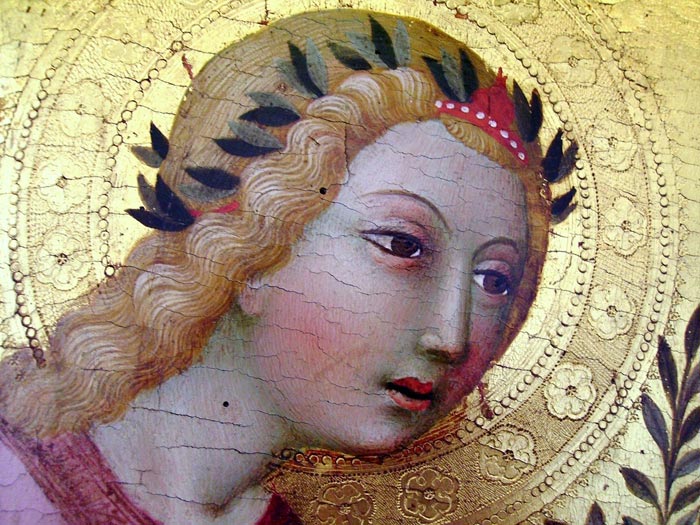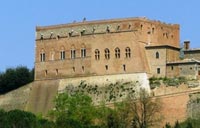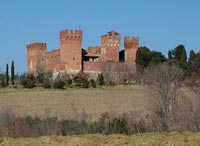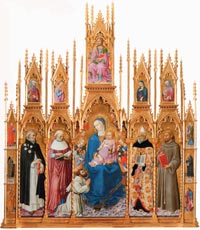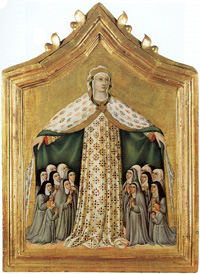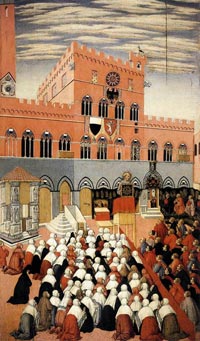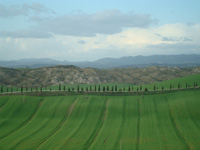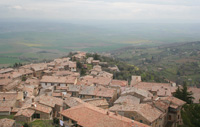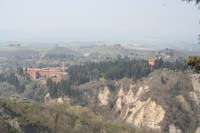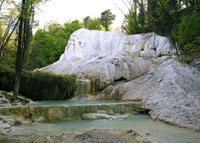| |
|
Sano di Pietro was one of the most prolific and successful Sienese painters, the head of a workshop that satisfied the demands of civic and religious institutions in the city as well as those of private devotion. His production, technically always of a very fine quality, rich in decorative effects, and characterized by a brilliant palette, often contains motifs that appear monotonous and repetitive. Although in 1428 he was already listed in the guild of Sienese painters, his work is well documented in its various stages only from 1444 (Gesuati polyptych) until his year of death (Pietà, Monte dei Paschi collection in Siena, 1481), whereas the question of his early activity is still open for discussion.
Esteemed in the nineteenth century literature as a sort of Fra Angelico of Sienese painting [1] and considered by some a typical representative of Sienese quattrocento mysticism,[2] Sano is much less appreciated by twentieth-century criticism. In 1931 Bernard Berenson called him "the most monotonous, the most spiritless, the most vapid" of the city's artists,[3] and almost all twentieth-century scholars feel that his production after the Gesuati polyptych of 1444 (Pinacoteca Nazionale, Siena, no. 246), which remains his earliest certain work, bears witness to a gradual but inexorable decline in his creative imagination and artistic capability.[4]
In reality Sano's development in the decades around the mid-century, marked by numerous dated works, is in no way lacking in paintings of high quality. Particularly fine examples are his miniatures, notably those done for the Opera della Metropolitana in Siena from 1445, for the monks of Monte Oliveto Maggiore between 1459 and 1463, for the Spedale della Scala in Siena, and for the duomo of Pienza around 1462. But also in other kinds of painting--a fresco for the office of the Biccherna in Siena; in 1448 the predella of the altarpiece for the chapel in Palazzo Pubblico; in 1449 the Scrofiano polyptych (Sinalunga; now in the Pinacoteca in Siena, no. 255); in 1456 the Pope Callixtus III (Pinacoteca, Siena, no. 241); in 1458 the polyptych in San Giorgio at Montemerano (Grosseto); in 1462 the altarpiece for the duomo of Pienza--the artist reveals gifts of narrative fantasy and chromatic freshness, although his manner remains deeply rooted in the habits and tastes of early Renaissance painting in Siena and appears little inclined toward renewal.
Along with works on a monumental scale, he produced numerous small panels, in response to the religious needs of a wide audience, and particularly to the spiritual tendencies represented in the Franciscan observance movement promoted by Saint Bernardino and the Sienese order of the Gesuati.
The proposal to identify the works of his youth as those gathered under the conventional name of the Master of the Osservanza, which, having the triptych dated 1436 in the Basilica dell'Osservanza in Siena as their point of departure, cover the period from the third decade of the century to 1444, has been rejected by many scholars, who prefer to consider the author of the 1436 triptych and works with similar characteristics an artist quite distinct from Sano, mainly because of their generally very fine quality. In 2002, however, Miklós Boskovits (author of the NGA systematic catalogue entries associated with the artist) is inclined, along with several other scholars, to accept the hypothesis first proposed by Berenson and Brandi identifying the Master of the Osservanza as the young Sano.
In his long and prolific career Sano di Pietro produced an impressive number of paintings, today scattered among he world's leading museums.
|
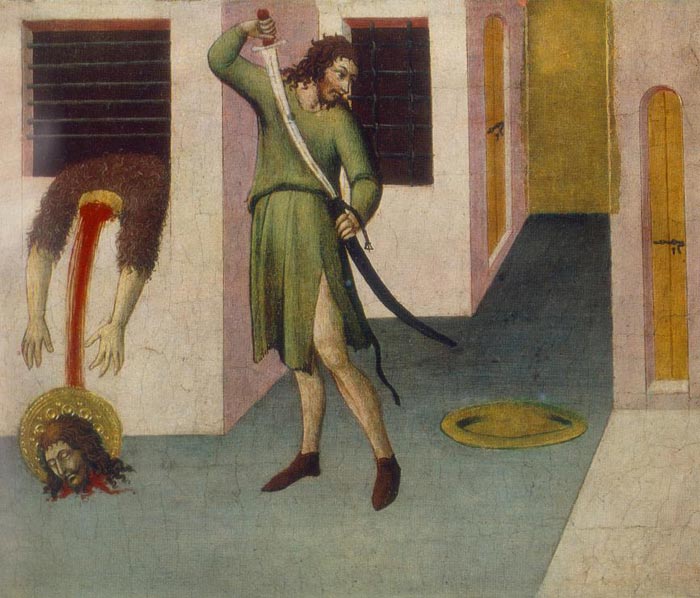 |
Sano di Pietro, Beheading of St John the Baptist, Pushkin Museum, Moscow |
| |
|
|
|
| |
|
| |
|
|
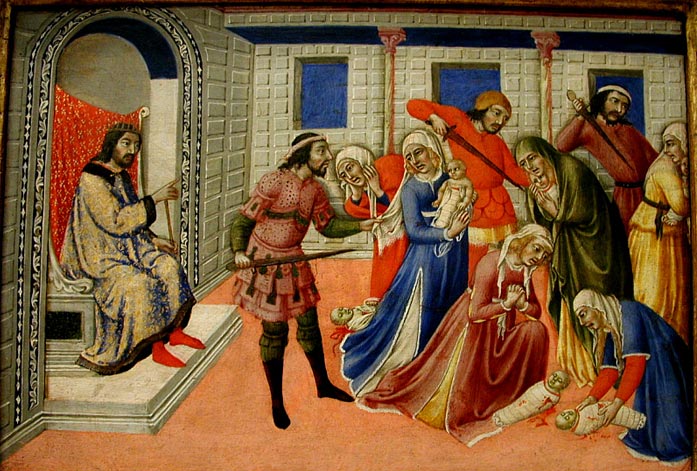 |
Sano di Pietro, The Massacre of the Innocents, 1470, Metropolitan Museum of Art, New York
|
The panels The Massacre of the Innocents, The Adoration of the Magi, and two others probably formed the predella of an altarpiece, probably that of the "Purification of the Virgin" formerly in the cathedral of Massa Marittima. The pictures, from about 1470, are typical of Sano's popular, conservative approach to painting, appreciated by the Franciscan order.
|
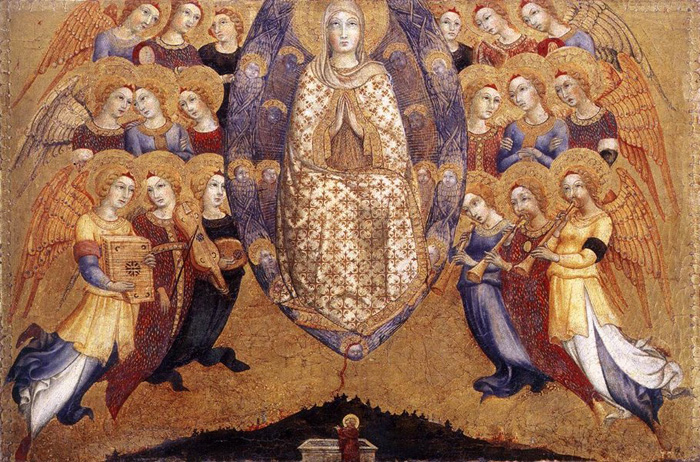 |
Sano di Pietro, Assumption of the Virgin, about 1447-1452, tempera and gold on panel, Altenburg, Staatliches Lindenau-Museum
|
This panel was part of a predella consisting of five scenes from the life of the Virgin. The predella was commissioned in 1448 from Sano di Pietro for an existing altarpiece in the Capella dei Signore in the Palazzo Pubblico in Siena. It is assumed that this altarpiece is identical with that painted by Simone Martini around 1326, and now dispersed in various collections.
The predella consist of the following scenes:
Birth of the Virgin (University of Michigan Museum of Art, Ann Arbor)
Presentation of the Virgin at the Temple (Pinacoteca Vatican, Rome)
Return of the Virgin (Lindenau-Museum, Altenburg)
Marriage of the Virgin (Pinacoteca Vaticana, Rome)
Assumption of the Virgin (Lindenau-Museum, Altenburg)
In the lower part of the Assumption of the Virgin, St Thomas is depicted in a strongly reduced scale. He is kneeling before the open tomb to receive the miraculous girdle of the Mother of God.
|
|
|
| His first documented work is the poliptych finished in 1444 for the church of the Gesuati in Siena (now in the Pinacoteca Nazionale), a dazzling complex of gold and fantastic colors. In his many subsequent altarpieces, often made with the help of his workshop assistants, Sano would never again reach similar heights of quality. A great many small panels for private devotion are also attributed to his hand, inspired for the most part by the great fourteenth-century tradition of Simone Martini. |
|
|
| The death of Saint Jerome among his disciples: he appears to Saint Cyril, bishop of Jerusalem. Part of a predella from an altar painted in 1444 for the former monastery of the Gesuati in Siena. |
|
|
| |
|
|
Sano di Pietro | Madonna of Mercy
|
 |
Sano di Pietro, Madonna of Mercy, ca. 1440. Private collection |
| |
| |
The Virgin of Mercy is a subject in Christian art, showing a group of people sheltering for protection under the outspread cloak of the Virgin Mary. It was especially popular in Italy from the 13th to 16th centuries, often as a specialised form of votive portrait, and is also found in other countries and later art, especially Catalonia and Latin America. In Italian it is known as the Madonna della Misericordia (Madonna of Mercy).
The oldest extant version is a small 13th Century piece by Duccio. The most famous example is The Madonna della Misericordia or The Polyptych of Misericordia, an altarpiece by Piero della Francesca in the Pinacoteca Comunale of Sansepolcro. Usually the image, whether in sculpture or painting, stands by itself, but in the Madonna della Misericordia altarpiece in Sansepolcro by Piero della Francesca, of 1445-62, the subject is the central panel of a large altarpiece, with a smaller Crucifixion above it, and many other panels.
the Virgin shelters a group of nuns, including two novices with uncovered heads.
Art in Tuscany | Madonna della Misericordia
|
|
|
| |
|
|
Saint Bernardino preaching in Siena before the Palazzo Publico. He is using a prop, a painting of the Name of Jesus inscribed in the Sun, a vision he claimed to have seen. Notice how the congregation is segregated between men and women.
Preachers frequently played major roles as unofficial influential powers in Florence and abroad. Long before Savonarola’s famous regime, the preachers had enormous influence on the politics and culture of Florence. Saint Bernardino of Siena and Saint Antonine influenced popular opinion greatly across class lines, which in turn, shaped government policy.
The Franciscan monk Saint Bernardino of Siena (1380 -1444) was, during his lifetime, one of the most successful and popular preachers in Italy.? He often gave sermons to audiences that were so large that they could not be accommodated within churches.? On many occasions he preached outside in squares and marketplaces, from pulpits especially constructed for him as appears in this picture.
|
|
|
| |
|
|
| Around 1450, the year in which St Bernardino was canonized Sano di Pietro was commissioned to paint numerous images of the patron saint of Siena. These historical events explain the large number of small devotional panels depicting the Madonna and Child flanked by St Bernardino and usually one other saint, of which the present panel is a fine example. The sunken cheeks of St Bernardino and the physiognomic resemblance among the various representations of the saint, are explained by the fact that Sano di Pietro apparently used a wax mask, taken of the saint's head at the moment of his death, to ensure an accurate likeness (a cast of the mask was at one time preserved at the museum of Aquila). |
|
 Madonna and Child with Sts Anthony Abbott and Bernardino of Siena, c. 1450 Madonna and Child with Sts Anthony Abbott and Bernardino of Siena, c. 1450
Private collection
|
The presence inside the museum in Buonconvento of an altarpiece on which Sano di Pietro has flanked the Virgin and Child with the saints Bernardine and Catherine of Siena offers the occasion to delve more deeply into the topic of these two “new” Sienese fifteenth-century saints.
The Franciscan Bernardino degli Albizzeschi (born in Massa Marittima in 1380, but Sienese by adoption) was one of the most famous preachers of the fifteenth century. After dying “in the odor of sanctity” in L’Aquila in 1444, he was canonized just a few years later, in 1450, to the great joy of the Sienese.
Little more than a decade later, in 1461, the Sienese pope Pius II canonized also the Dominican nun Caterina Benincasa (Siena, 1347-1380), who is celebrated today mainly for having fostered the return of the papacy from Avignon, but in the fifteenth century was greatly venerated by the Dominican order for, among other things, having been given the honor of miraculously receiving the stigmata.
Sano di Pietro’s altarpiece, datable to the 1460s, bears good witness to the “success” of the two new saints, who would soon join the traditional patrons Ansanus, Crescentius, Sabinus, and Victor as the true advocates for the city of Siena.
Bernardine’s popularity resulted in the portrait of this gaunt friar (usually shown with the panel of the monogram of Christ which he would hold up to the crowd during his sermons) becoming a favorite subject for altarpieces, starting immediately after his death and even before his canonization, as demonstrated by numerous works on display in the exhibition and others in museums in and around Siena. Among his most authoritative “iconographers” were Sassetta, Pietro di Giovanni Ambrosi, Sano di Pietro and Vecchietta, who unquestionably knew him personally.
|
|
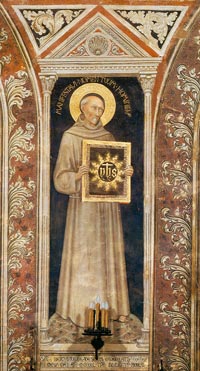
Saint Bernardino of Siena, 1463, fresco Siena, Palazzo Publico, Sala del Mappamondo
|
| The cult of the Virgin had rapidly established in the art of Duccio and the Lorenzetti brothers soon after Montaperti. The artists of the later-15th and early-16th century were aware of this rich inheritance, and developed a vocabulary in which art and politics in a late medieval city state could be combined and over which the Madonna could reign supreme. |
|
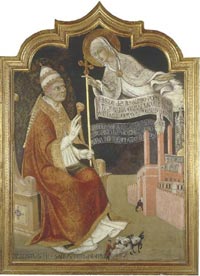
The Virgin Recommends Siena to Pope Callixtus III (1456) by Sano di Pietro (1405-81)
|
| It is still not clear if this panel was originally an isolated painting imitating thirteenth-century altar dossals or was the lunette of a monumental altarpiece. What is certain is that it is a fully typical, mature work by Sano di Pietro, a master as prolific as he was traditional, who is appreciated above all for the quality of his colors and working of the parts in gold of his panels, which emanate a clear nostalgia for the great fourteenth-century season of Sienese paintings. It cannot be ruled out that there was an older archetype also for the composition of this scene in which Sano illustrates the Coronation of the Virgin, an episode of sacred history dear to the hearts of the Sienese, who venerated Mary as their advocate from the time of the Battle of Montaperti (1260). |
|
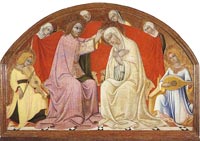
Sano di Pietro, The Coronation of the Virgin, Monteroni d’Arbia (Siena), church of S. Albano a Quinciano, 1450-55
|
| |
|
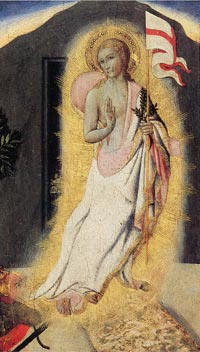
Sano di Pietro, Resurrection, about 1444-1445, Cologne, Wallraf-Richartz-Museum |
In 1432 Sano di Pietro assessed Sassetta's Virgin and Child with Saints (the 'Madonna of the Snow'; Florence, Pitti), and after Sassetta's death in 1450, Sano completed works left unfinished by him, including the fresco of the Coronation of the Virgin over the Porta Romana (1458-66), Siena, and the St Francis (Siena, Pin. N.).
|
|
|
During the early Renaissance, the art of manuscript illumination flourished
Manuscript production in Siena was limited primarily to the commissioning of liturgical choir-books for the cathedral, the Hospital of Santa Maria della Scala, and the most important monastic churches. Until the last decades of the fifteenth century, the illumination of these volumes was entrusted to prominent local painters, from the Osservanza Master to Sano di Pietro and Francesco di Giorgio.
This miniature was originally included in an antiphonary volume illuminated by Sano di Pietro for the Hospital of Santa Maria della Scala in Siena. The scene inside the initial D illustrates one of the responses for the Feast of Saint Agatha (February 5): "Dum torqueretur beata Agatha in mamilla graviter dixit ad iudicem impie crudelis et dire tyranne" (While blessed Agatha was being cruelly tortured in her breasts, she said to the judge: godless, cruel, infamous tyrant).
The Hospital choirbooks, written and decorated between 1456 and 1476/77, represent one of the largest and most prestigious manuscript commissions in fifteenth-century Siena. Sano di Pietro, who by the mid-fifteenth century was one of the principal painters and illuminators in Siena, was entrusted with the decoration of at least five of the twenty volumes in the series. The Lehman Saint Agatha is one of many initials and full leaves painted by his hand that were removed from these books and sold to collectors sometime during the nineteenth century, before transfer of the choirbooks to the Museo dell'Opera del Duomo.
|
|

Sano di Pietro, Martyrdom of Saint Agatha in an Initial D: Cutting from an Antiphonary, ca. 1470–73, Robert Lehman Collection |
| 
Literature E. Gaillard, Sano di Pietro, Chambéry, 1923, pp. 176-7, no. 203, illustrated.
B. Berenson, Pitture italiane del Rinascimento, Milan, 1936, p. 429.
B. Berenson, Italian Pictures of the Renaissance: Central Italian and North Italian Schools, London, 1968, I, p. 375
Christiansen, K. , in Renaissance Painting in Siena, exhib. cat. 1989 (New York, Met. Mus.). Sano di Pietro | Biography, Renaissance Painting in Siena
|
Since its incorporation into Siena's first public art collection early in the nineteenth century, the provenance of Sano di Pietro's polyptych of The Virgin of the Assumption with Saints has been recognised as the Clarissan church of Santa Petronilla. To date, however, there has been very little comment as to the significance of the provenance of the altarpiece, particularly in relation to the choice of subject matter. This essay explores the complex history of this major Clarissan foundation in Siena, identifying its first location beyond Siena's principal northern gate of Porta Camollia and then describing its subsequent removal during the mid sixteenth century into the safety of the city itself and to the church where the altarpiece was discovered in 1810. Recognising that the presence of a Clarissan donor figure on the central painting of the polyptych provides plausible evidence that the altarpiece was commissioned for the original convent church, the essay further demonstrates how the circumstances of the foundation of Santa Petronilla in the second decade of the thirteenth century provide a key for the principal subject matter of the altarpiece. The remaining imagery of the altarpiece is then discussed in terms of its general relevance for a fifteenth-century community of Clarissan nuns and for the particular devotional concerns of the nuns of Santa Petronilla. It is argued that this late fifteenth-century Sienese altarpiece offers a revealing example of the way in which art commissioned by enclosed orders of female religious within Renaissance Italy could be closely related to their own concerns and priorities.
Diana Norman, Sano di Pietro's Assunta polyptych for the Convent of Santa Petronilla in Siena, Renaissance Studies, Volume 19, Issue 4, pages 433–457, September 2005.| onlinelibrary.wiley.com
|
| Restoration of the Gesuati Polyptych by Sano di Pietro
The polyptych is one of the biggest realized by the author, measuring 335 cm x 291 cm. It is the first work by Sano di Pietro, signed and dated, and it is recognized by critics as the most important achievement by the artist.
The restoration was carried out by our Studio in the National Gallery in Siena and was directed by Anna Maria Guiducci, director of the Gallery. The works lasted about six months. Several non-invasive diagnostic tests were conducted in cooperation with the Opificio delle Pietre Dure and the CNR.
The polyptych, that underwent several restorations in the past, appeared disfigured by layers of blackened purple, by fake patina, old stucco, and some damages caused by inadequate cleaning attempts were especially evident in the blue mantle of the Madonna, painted with lapislazuli.
The restoration was funded by Vernice Progetti Culturali srl of Monte dei Paschi Foundation in order to expose the masterpiece in Santa Maria della Scala museum complex on the occasion of the largest exhibition event that the city of Siena has organized in recent years: “From Jacopo Della Quercia to Donatello. The Arts in Siena in the early Renaissance”. The exhibition lasts from March 26th to July 11th,2010 and it is curated by Max Seidel of the Max-Plank Institut in Florence.
|

[1] Auguste F. Rio, De l'art chrétien, 4 vols., Paris, 1861: 1:98: "Sano... on pourrait appeler le fra Angelico de l'école siennoise" ("Sano... could be called the Fra Angelico of the Sienese school").
[2] Gaillard 1923, 184: "L'art de Sano di Pietro est essentiellement représentatif de la mystique siennoise du XVe siècle" ("the art of Sano di Pietro is essentially representative of fifteenth-century Sienese mysticism").
[3] Berenson 1930, reprint (1969), 50.
[4] Torriti 1977, 256, observes, for example, in speaking of the 1444 polyptych, "[S]embra veramente incredibile come Sano, senza prima aver nulla creato, possa essere giunto d'improvviso... a questo fulgido capolavoro per poi immediatamente dopo iniziare un lento declino nelle sue cento e cento opere" ("[I]t seems truly incredible that Sano, without having created anything before, could suddenly have achieved... this splendid masterpiece and then immediately afterward begun a slow decline in his hundreds of works").
[5] See Berenson 1909, Italian ed. (1946), 51-52, and Cesare Brandi, "Introduzione alla pittura senese del primo Quattrocento," La Rassegna d'Italia 1 (1946): 31.
'Since its incorporation into Siena's first public art collection early in the nineteenth century, the provenance of Sano di Pietro's polyptych of The Virgin of the Assumption with Saints has been recognised as the Clarissan church of Santa Petronilla. To date, however, there has been very little comment as to the significance of the provenance of the altarpiece, particularly in relation to the choice of subject matter. This essay explores the complex history of this major Clarissan foundation in Siena, identifying its first location beyond Siena's principal northern gate of Porta Camollia and then describing its subsequent removal during the mid sixteenth century into the safety of the city itself and to the church where the altarpiece was discovered in 1810. Recognising that the presence of a Clarissan donor figure on the central painting of the polyptych provides plausible evidence that the altarpiece was commissioned for the original convent church, the essay further demonstrates how the circumstances of the foundation of Santa Petronilla in the second decade of the thirteenth century provide a key for the principal subject matter of the altarpiece. The remaining imagery of the altarpiece is then discussed in terms of its general relevance for a fifteenth-century community of Clarissan nuns and for the particular devotional concerns of the nuns of Santa Petronilla. It is argued that this late fifteenth-century Sienese altarpiece offers a revealing example of the way in which art commissioned by enclosed orders of female religious within Renaissance Italy could be closely related to their own concerns and priorities. (pp. 433–457)'
Diana Norman, Sano di Pietro's Assunta polyptych for the Convent of Santa Petronilla in Siena | www.onlinelibrary.wiley.com
|
| |
|
|
|
|
| |
|
|
| |
|
|
|
|
|
Podere Santa Pia |
|
|
|
Val d'Orcia |
| |
|
|
|
|
|
|
|
|
|
Montalcino
|
|
Monte Oliveto Maggiore abbey |
|
Bagni San Filippo |
| |
|
|
|
|
|
|
|
|
 |
San Giovanni d'Asso |
|
The Castle of Gallico |
|
|
Painting in Siena
In the earlier years of the 13th century Guido da Siena, despite his great obscurity, is regarded as sharing with Coppo di Marcovaldo the honour of founding the Sienese School. The real founder, however, of the Sienese school was Duccio di Buoninsegna. In his work the grace and humanity and the power of emotional expression of the figures dominated the hieratic style of the Byzantine tradition. His masterpiece - and the only work which can be attributed to him with certainty - is the great altarpiece of the Maestà (1308-1311), painted for Siena cathedral and now in the Opera del Duomo, Siena (parts of it are also in the National Gallery, London, the Frick Collection, New York, and the National Gallery, Washington). The Rucellai Madonna, formerly attributed to Cimabue but now considered Duccio's work, shows Florentine influence.
In the 14th century Siena, a Ghibelline stronghold having close ties with Naples, Milan and France (Avignon), became a centre of the refined, intellectual, courtly trend of which the art of Simone Martini (c. 1284-1344) is a typical example. Simone's first work was the Maestà in the Palazzo Pubblico, Siena (1315). His equestrian portrait of Guidoriccio da Fogliano 1328 recalls the epic poems of chivalry. Between 1320 and 1330 he painted frescoes in the chapel of St Martin in the lower church of S. Francesco at Assisi; in Naples he painted St Louis of Toulouse Crowning Robert of Anjou (1317); in 1339 he went to Avignon where he died in 1344. His finest work is perhaps the Annunciation in the Uffizi, Florence (1333). His last works, such as the Orsini Polyptych in the Koninklijk Museum voor Schone Kunsten, Antwerp, were more dramatic and emotional and had an even more refined linearity. His chief follower was Lippo Memmi (active by 1317; d. c. 1356).
Pietro Lorenzetti (d. 1348) and more particularly his brother Ambrogio Lorenzetti (d. 1348) brought Giotto's influence to Sienese painting. Many of Pietro's powerful paintings show the influence of Duccio and of Simone Martini, for example: altarpiece in the church of Sta Maria della Pieve, Arezzo (1320); Carmelite Altarpiece (1329, Pinacoteca, Siena); Birth of the Virgin (1342, Opera del Duomo, Siena). While working on the frescoes in the Lower Church at Assisi he came under the influence of Giotto. Ambrogio Lorenzetti's best works are his frescoes of the Effects of Good and Bad Government (1337-1339, Palazzo Pubblico, Siena), which represent the zenith of naturalism in 14th-century Italian painting. The last notable 14th-century Sienese painter was Barna da Siena (active middle of the 14th century).
In the 15th century the school of Siena, which had fallen behind, was faithful to its past: awareness of new trends, but used for non-realistic ends. The two leading painters were Sassetta (1392-1450) and Giovanni di Paolo (1403-1483). Sassetta's first known work is the now dissembled Altar of the Eucharist (1423), his most important work being the St Francis Altarpiece painted for Borgo S. Sepolcro (1437-1444) and now dispersed. The main works of Giovanni di Paolo are the panels of the life of John the Baptist (also dispersed). Matteo di Giovanni (1435-1495) and Francesco di Giorgio (1439-1501), architect, sculptor and painter, were more affected by Florentine influences.
In the 16th century Raphael's followers included Sienese artists, by birth or adoption: the decorator Baldassare Peruzzi and his friend Bazzi, known as Il Sodoma (d. 1549), who was also influenced by Leonardo. The most important Mannerist painter in Siena was Domenico Beccafumi (1485-1551); he had a highly personal style with intensity of emotion and use of shot colour as seen in the Birth of the Virgin, (Siena).
The decline of Sienese painting from the second half of the 14th century is so splendidly described by Bernard Berenson in his essay The Central Italian Painters (first published in 1897) that it is worth to quote it in its entirety.
Art in Tuscany | Sienese school of painting
|
|
|
